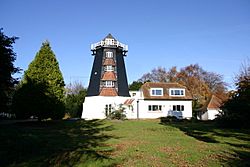Rock Mill, Washington facts for kids
Quick facts for kids Washington Windmill |
|
|---|---|

The mill in 2005
|
|
| Origin | |
| Mill name | Rock Mill |
| Grid reference | TQ 128 137 |
| Coordinates | 50°54′42″N 0°23′48″W / 50.9117°N 0.3966°W |
| Operator(s) | Private |
| Year built | 1823 |
| Information | |
| Purpose | Corn mill |
| Type | Smock mill |
| Storeys | Three store smock |
| Base storeys | Single-storey base |
| Smock sides | Eight sides |
| No. of sails | Four sails |
| Type of sails | Patent sails (missing) |
| Winding | Fantail (missing) |
| No. of pairs of millstones | Three pairs |
|
Listed Building – Grade II
|
|
| Official name | Rock Windmill |
| Designated | 24 February 1977 |
| Reference no. | 1354092 |
Rock Mill is a special type of windmill called a smock mill. It's located in Washington, a village in West Sussex, England. This old mill, which used to grind grain, has now been turned into a home. It's also recognized as a Grade II listed building, which means it's an important historical structure.
The Story of Rock Mill
Rock Mill was built a long time ago, in 1823. It worked as a busy mill, grinding corn, right up until the start of the First World War. Around 1919, the mill was changed into a house. Its old machinery was kept inside, but only for decoration.
In 1953, a famous composer named John Ireland bought Rock Mill. He lived there until he passed away in 1962. As of 2007, the mill is used as offices.
What is Rock Mill Like?
Rock Mill is a three-story smock mill. This means it has a wooden tower that looks a bit like a person wearing a smock (a loose outer garment). This tower sits on a single-story base, which is the bottom part of the mill.
The mill used to have a special top called a "beehive cap." It also had a fantail, which is like a small propeller at the back. The fantail would automatically turn the mill's cap so the main sails always faced the wind.
Rock Mill had four large Patent sails. These were special sails that could adjust themselves automatically to catch the wind. Inside, the mill used to have three pairs of millstones. These heavy stones would grind corn into flour. Two pairs were "French Burr" stones, and one pair was "Peak stones."

